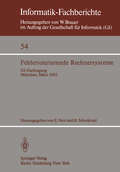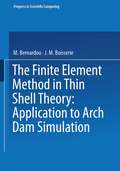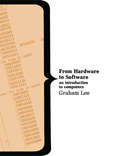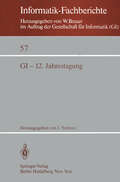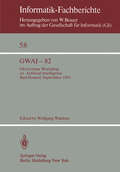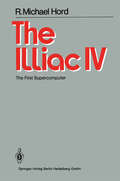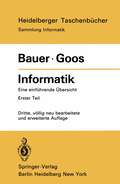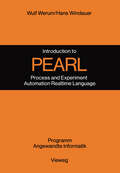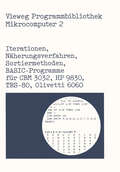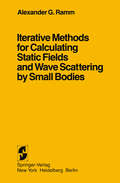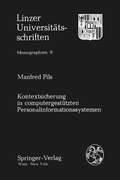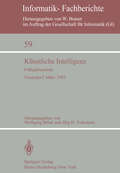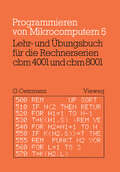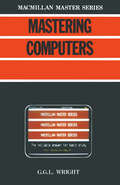- Table View
- List View
Die endliche Fourier- und Walsh-Transformation mit einer Einführung in die Bildverarbeitung: Eine anwendungsorientierte Darstellung mit FORTRAN 77-Programmen
by Klaus NiederdrenkDigital Picture Processing (Computer Science and Scientific Computing #Volume 2)
by Azriel RosenfeldDigital Picture Processing
Digital Picture Processing (Computer Science and Applied Mathematics #Volume 1)
by Azriel Rosenfeld Avinash C. KakThe rapid rate at which the field of digital picture processing has grown in the past five years had necessitated extensive revisions and the introduction of topics not found in the original edition.
Einführung in die Programmiersprache BASIC: Anleitung zum Selbststudium ; Skriptum für Hörer aller Fachrichtungen ab 1. Semester
by Wolf-Dietrich SchwillEinführung in die Programmiersprache PASCAL: Skriptum für Hörer aller Fachrichtungen ab 1. Semester
by Karl-Heinz BeckerEinführung in die Programmiersprache SIMULA: Anleitung zum Selbststudium
by Günther LamprechtDiese Einführung in die Programmiersprache SIMULA ist aus Lehrveranstaltungen entstanden, die seit mehreren Jahren am Rechenzentrum der Universität Bremen abgehalten wurden. Das Buch wendet sich an .,Hörer aller Fakultäten" und will ihnen den Zugang zur Datenverarbeitung an Hand einfacher Aufgabenstellungen erleichtern. Die Programmiersprache SIMULA, die am Norwegian Computing Center von 0. J. Dahl, B. Myhrhaug und K. Nygaard entwickelt wurde, ist eine Erweiterung der Programmiersprache ALGOL 60. Die Sprache bietet eine Fülle von Anweisungen, so daß man den Lösungsweg auch bei komplexer Aufgabenstellung übersichtlich beschreiben kann. Das Ziel dieser Einführung in die Programmiersprache SIMULA ist es, den Leser nach und nach mit den Sprachelementen vertraut zu machen. Dabei kommt es weniger darauf an, die Sprache vollständig zu beschreiben, als vielmehr, beispielhaft zu zeigen, wie man die einzelnen Anweisungen anwenden kann. Die Programmierbeispiele und Aufgaben wurden auf der Rechenanlage Siemens 7.880 der Universität Bremen gerechnet und die Ergebnisse im Lösungsteil angegeben und erläutert. Damit hat der Leser die Möglichkeit, seine eigenen Programme und Ergebnisse zu kontrollieren. Herrn Dr. Lohmann möchte ich für die Durchsicht des Manuskripts und Frau U. Kleinschmidt für ihre Sorgfalt beim Schreiben der Druckvorlagen danken. Bremen, im April 1982 G. Lamprecht -I- 1 Ein einfaches Programmierbeispiel Es soll mit Hilfe der Rechenanlage die Funktion 2 y = 0,3 x + 0,25 x - I an der Stelle x = 0,5 berechnet werden. Wie man leicht nachrechnen kann, muß das Ergebnis -0,8 lauten. Das SIMULA-Programm soll angegeben und anschließend erläutert werden.
Einführung in PASCAL: Mit zahlreichen Beispielen und 10 vollständigen Programmen (Programmieren von Mikrocomputern #4)
by Wolfgang SchneiderErzeugung interaktiver Bildverarbeitungssysteme im Dialog: Konzepte, Entwurf und Implementierung eines Dialogsystems für die Bildverarbeitung in der Medizin (Informatik-Fachberichte #51)
by G. PfeifferThe Expression of Knowledge: Neurobehavioral Transformations of Information into Action
by Robert L. Isaacson Norman E. SpearWhat we know about the world and its opportunities limits what we do. If we do not know that there is a pot of gold at the end of the rainbow, we will not follow it. If we do not know that a desert cactus contains water, we will not cut into it for sustenance. Often, however, we do know things about the world and yet the knowledge does not seem to be reflected in behavior. Explaining this fact simply in terms of inadequate motivation for expression or incomplete memory for the important in formation does not really add much to our understanding. The ex pression of knowledge can be interrupted in very special ways by a variety of more specific conditions-fatigue, sources of forgetting that may include failure of memory retrieval, emotion, and various dysfunc tions of brain and body systems-that are not satisfactorily incorporated by any current theories of motivation or memory. Also, a dissociation between knowledge and its expression can take the form of applying knowledge without apparent awareness of this action, a phenomenon that requires complicated assumptions for explanation in terms of either motivation or memory. Dissociations between knowledge and action may be striking. After driving home on a familiar route we may not be able to report whether the last three traffic lights were red or green; yet we must have re sponded appropriately to them.
Fehlertolerierende Rechnersysteme: GI-Fachtagung München, 11.–12. März 1982 Gemeinsam veranstaltet von GI-Fachausschuß 8 und Fachausschuß 11 und GMD-Institut für Rechner- und Programmstrukturen, Siemens AG (Informatik-Fachberichte #54)
by E. Nett Heinz SchwärtzelThe Finite Element Method in Thin Shell Theory: Application to Arch Dam Simulations (Progress in Scientific Computing #1)
by Bernardou Boisserie~his Monograph has two objectives : to analyze a f inite e l e m en t m e th o d useful for solving a large class of t hi n shell prob l e ms, and to show in practice how to use this method to simulate an arch dam prob lem. The first objective is developed in Part I. We record the defi- tion of a general thin shell model corresponding to the W.T. KOlTER linear equations and we show the existence and the uniqueness for a solution. By using a co nform ing fi nite e l e m ent me t hod , we associate a family of discrete problems to the continuous problem ; prove the convergence of the method ; and obtain error estimates between exact and approximate solutions. We then describe the impl em enta t ion of some specific conforming methods. The second objective is developed in Part 2. It consists of applying these finite element methods in the case of a representative practical situation that is an arc h dam pro b le m. This kind of problem is still of great interest, since hydroelectric plants permit the rapid increase of electricity production during the day hours of heavy consumption. This regulation requires construction of new hydroelectric plants on suitable sites, as well as permanent control of existing dams that may be enlightened by numerical stress analysis .
GI-12. Jahrestagung: Kaiserslautern, 5.–7. Oktober 1982 Proceedings (Informatik-Fachberichte #57)
by J. NehmerDie 12. Jahrestagung der Gesellschaft für Informatik an der Univer sität Kaiserslautern steht unter dem thematischen Schwerpunkt nSYSTEMS ENGINEERING" in der Informatik. Unter dem Druck einer sehr geringen Zahl einge reichter Beiträge sind wir von dem Konzept der Vorjahre abgerückt, die Tagung überwiegend aus eingereichten Beiträgen zu bestreiten. Der zweite Tag hat durch die eingeladenen tfbersichtsvorträge einen vor wiegend tutorialen Charakter und soll der Jahrestagung gegenüber den vielen Fachtagungen eine eigenständige Attraktivität verleihen. Die in tfbersichtsvorträgen behandelten Themen sollen den hier anwesenden Fachleuten Gelegenheit bieten, sich bequem über außerhalb des eigenen Arbeitsgebiets sich abzeichnende neue Entwicklungen zu informieren. Dem Programmkomitee, den Programmausschüssen der Fachgespräche sowie dem Organisationskomitee am Tagungsort sei an dieser Stelle für ihren Beitrag zum Gelingen der Tagung herzlich gedankt. Kaiserslautern, Juli 1982 Jürgen Nehmer FOLGENDE FIRMEN HABEN DIE VORBEREITUNG UND AUSRICHTUNG DER TAGUNG FINANZIELL UNTERSTÜTZT: SIEMENS AG IBM DEUTSCHLAND GMBH BASF AG BROWN, BOVERI & CIE. AG TELEFONBAU & NORMALZEIT GMBH GEBR. KITTELBERGER GMBH & CO.
GWAI-82: 6th German Workshop on Artificial Intelligence Bad Honnef, Sept. 27. – Oct. 1, 1982 (Informatik-Fachberichte #58)
by W. WahlsterThe Illiac IV: The First Supercomputer
by R.M. HordThe Illiac IV was the first large scale array computer. As the fore runner of today's advanced computers, it brought whole classes of scientific computations into the realm of practicality. Conceived initially as a grand experiment in computer science, the revolutionary architecture incorporated both a high level of parallelism and pipe lining. After a difficult gestation, the Illiac IV became operational in November 1975. It has for a decade been a substantial driving force behind the develooment of computer technology. Today the Illiac IV continues to service large-scale scientific aoolication areas includ ing computational fluid dynamics, seismic stress wave propagation model ing, climate simulation, digital image processing, astrophysics, numerical analysis, spectroscopy and other diverse areas. This volume brings together previously published material, adapted in an effort to provide the reader with a perspective on the strengths and weaknesses of the Illiac IV and the impact this unique computa tional resource has had on the development of technology. The history and current status of the Illiac system, the design and architecture of the hardware, the programming languages, and a considerable sampling of applications are all covered at some length. A final section is devoted to commentary.
Informatik: Eine einführende Übersicht Erster Teil (Heidelberger Taschenbücher #80)
by F. L. Bauer Gerhard GoosIntroduction to PEARL: Process and Experiment Automation Realtime Language Description with Examples (Sammlung Vieweg)
by Wulf WerumIterationen, Näherungsverfahren, Sortiermethoden: BASIC-Programme für CBM 3032, HP 9830, TRS-80, Olivetti 6060 (The Wadsworth & Brooks/Cole Statistics/Probability Series)
by Harald SchumnyIterative Methods for Calculating Static Fields and Wave Scattering by Small Bodies
by Alexander G. RammIterative methods for calculating static fields are presented in this book. Static field boundary value problems are reduced to the boundary integral equations and these equations are solved by means of iterative processes. This is done for interior and exterior problems and for var ious boundary conditions. Most problems treated are three-dimensional, because for two-dimensional problems the specific and often powerful tool of conformal mapping is available. The iterative methods have some ad vantages over grid methods and, to a certain extent, variational methods: (1) they give analytic approximate formulas for the field and for some functionals of the field of practical importance (such as capacitance and polarizability tensor), (2) the formulas for the functionals can be used in a computer program for calculating these functionals for bodies of arbitrary shape, (3) iterative methods are convenient for computers. From a practical point of view the above methods reduce to the cal culation of multiple integrals. Of special interest is the case of inte grands with weak singularities. Some of the central results of the book are some analytic approximate formulas for scattering matrices for small bodies of arbitrary shape. These formulas answer many practical questions such as how does the scattering depend on the shape of the body or on the boundary conditions, how does one calculate the effective field in a medium consisting of many small particles, and many other questions.
Kontextsicherung in computergestützten Personalinformationssystemen (Linzer Universitätsschriften #8)
by M. PilsPraxis und Wissenschaft halten nach neuen Miiglichkeiten Ausschau, um die sich immer weiter entwickelnde Computertechnologie In zunehmendem MaBe such fOr die Personalarbeit In Unternehmungen und offentIichen Verwalt~ngen einzusetzen. Man blickt hierbei insbesondere auf die groBere Anzahl von personenbezogenen Daten, die in den meisten Betrieben iiber jeden Arbeitnehmer vorliegen und die sich im Verlaufe des Dlenstverhiiltnisses in den Personalakten oder an sonstigen Stellen im Betrieb angesammelt haben: Bewerbungsunterlagen, Zeugnlsse, Angaben iiber Krankenstiinde, Mitarbeiterbeurteilungen, Ergebnisse psychologischer Tests, um nur einige Miiglich keiten zu nennen. Verstiirkt befaBt man sich in letzter Zeit mit Fragen, wie man nicht nur fiir die Personalabrechnung, sondern auch fOr die Planung des Personalbedarfes, fOr das Beschaffen und Einsetzen von Mitarbeitern oder such fiir die Aus-und Weiterblldung, also fiir die gerade in der heutigen Zeit brennenden Probleme der betrieblichen Personalarbeit, eine Computerunterstiitzung planen sollte. Personalinformationssysteme liegen im Schnittpunkt sich teilweise erheblich wider sprechender Interessen. Der Autor legt Wert auf die Feststellung, daB L6sungen auf diesem Gebiet nur im Einvernehmen mit siimtlichen Betroffenen (Unternehmenslel tung, Benutzer, Arbeitnehmer und deren Vertreter usw. ) sinnvoll sein werden. Dieser Gedanke zieht sich wie ein roter Faden durch dieses Buch, ebenso wie die Prioritiiten setzung der Ziele der Systemgestaltung (Humanisierungsstreben rangiert vor Wirt schaftIichkeitsstreben, letzteres vor der technologlschen Realisierbarkeit). Der Autor vertritt seit Jahren eine kritische HaItung gegeniiber der Speicherung personenbezo gener Daten; als einer der ersten ist er bereltli vor Jahrengegen jedes einseitige Automatisierungsstreben im Bereich der Personalarbeit eingetreten.











